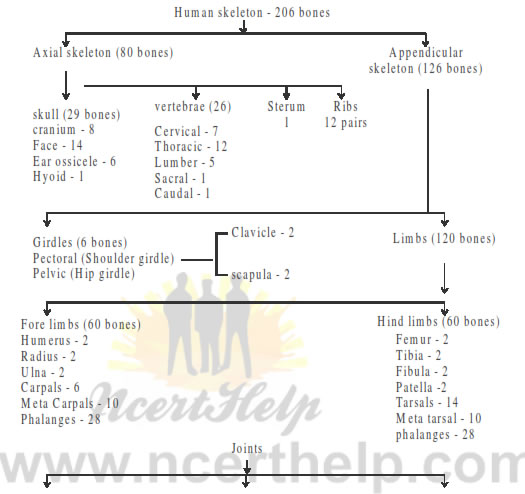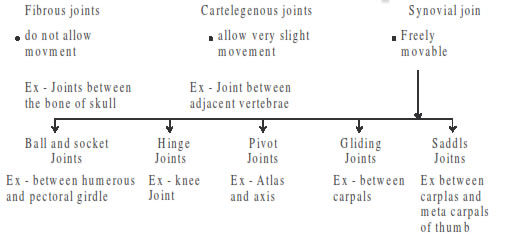
locomotion and movement notes for class 11 download in pdf, cbse notes, cbse syllabus, cbse class notes, cbse ncert answers, notes cbse , locomotion and movement 11 notes, class 11 biology notes, locomotion and movement class 11, locomotion and movement class 11 notes, class 11 locomotion and movement, note biology, biology notes, locomotion and movement, class 11 cbiology chapter 20 notes, 11th standard biology notes, 11th std biology notes, class 11 biology notes chapter 20, locomotion and movement chapter class 11 notes
Arthritis : an enflamm atory joint diease characteresed by enflammation of joints.
Coccyx : tail bone formed by fusion of four coccygeal vertebrae in man.
Dicondylic Skill : A Skull with two occipital condyles.
Endo Skeleton : A skeleton present outside the body.
Fascicule : Bundles of muscles febers held together by connective tissue.
Fascia : Collagenous connective tissue layer that surrounds muscle bundles.
Floating ribs : The ribs that remain free anteriorly.
False ribs : The ribs whose sternal part are join to sternal part of a true rib.
Myoglobin : A red coloured pigment present in sarcoplasm of muscle.
Sarcolema : A portion of myofibril between two successive ‘Z’ lines.
Sarcocolema : The plasma membrane of a muscle.
Gout : Inflammation of joints due to accumulation of uric acid crystal.
Suture : immovable joints between skull bones.
Synovial joints : Freely movable joints between limb bones.
Patella : A sesamoid bone acting as kneecap
Intervertebral disc : Fibro carti lagenous pad present between the vertebrae and
act as shock absorbers.
L.M.M : Light meromyosin
HMM : Heavy meromysoin
1. Amoeboid movement : These movement takes place in phagocytes where
leucocytes and macrophages migrate through tissue. It is affected by pseudepodia
formed by the streaming of protoplasm (as in amocba)
2. Celiary movement : These movement occurs in internal organs which are
lined by ciliary epithelium.
3. Muscular Movement : This movement involve the muscle fibers, which
have the ability to contract and relex.
(i) Excitability
(ii) Contractility
(iii) Extensibility
(iv) Elasticity
(a) Skeletal muscles or striated muscles :- These involved in locomotion
and change of body postures. Thes are also known as voluntary muscles.
(b) Visceral muscles or smooth muscles :- These are located in inner wall
of hollow visceral organ, smooth in appearance and their activity are not
under control of nervous system.
(c) Cardiac muscles :- The muscles of heart, involuntary in nature, steriated
and branched, These are uni nucleated.
• Each myofibril consist of alternate dark and light band.
• Dark band :- contain myosim protien and is called A-band or Anisotroic band.
• Light band :
- Contain actin protien and is called I Band or Isotropic band.
•
I Band is bisected by an elastic fiber called ‘Z’ line. Actin filament (thin flament)
are firmly attached to the ‘Z’ lines.
•
Myosin filament (thick filament) in the ‘A’ Band are also held together in the
middle of ‘I’ Band by thin fibrous membrane called ‘M’ line.
•
The portion between two successive ‘Z’ lines is considered as functional unit
of contraction and is called a sarcomere.
Mechenism of Muscle contraction : Sliding filament theory.
The contraction of musle fiber takes place by the sliding of actin (thin flament) on
myosin ( thick filament).
•
Muscle contraction is initiated by a signal sent by the CNS via a motor
neuron.
•
Impulse from motor nerve stimulates a muscle fiber at neuro muscular
junctions.
•
Neurotransmitter releases here which generates an action potential in
sarcolema.
•
These causes release of Ca
++
into sarcoplasm.
• These Ca
binds with
troponin, thereby remove masking of active site.
•
Myosin head binds to exposed active site on actin to form a cross bridge,
utilising energy from ATP hydrolysis.
•
This pulls the acin filament towards the centre of ‘A’ band.
‘Z’ lines also pulled inward thereby causing a shortning of sarcomere i.e.
contraction.
‘I’ band get reduced, whereas the ‘A’ band retain the length.
•
During relexation, the cross bridge between the actin and myosin break. Ca
pumped back to sarcoplasmic cesternae.
• Actin filament slide out of ‘A’ band
and length of ‘I’ band increases.
• This returns the muscle to its original state.


Copyright @ ncerthelp.com A free educational website for CBSE, ICSE and UP board.